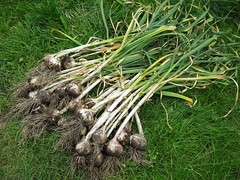Garlic (Allium sativum)
On this page... (hide)
- 1. Description
- 2. Growth
- 3. Obtainment
- 4. Uses
- 5. Cautions
- 6. More
- 7. 'Souls
| Common Name | Garlic |
| Latin Name | Allium sativum |
| Icon(s) | 
|
|
"Garlic Harvest" | |
1. Description
Garlic is a species of onion, related to the onion, shallot, and leek. It is a bulbous plant. Garlic plants are usually very hardy, and are not attacked by many pests or diseases. Garlic plants are said to repel rabbits and moles.
There are different types or subspecies of garlic, most notably hardneck garlic and softneck garlic. The latitude where the garlic is grown affects the choice of type as garlic can be day-length sensitive. Hardneck garlic is generally grown in cooler climates; softneck garlic is generally grown closer to the equator.
2. Growth
Garlic is easy to grow and can be grown year-round in mild climates. In cold climates, cloves are planted in the fall, about six weeks before the soil freezes, and harvested in late spring. Garlic plants can be grown closely together, leaving enough space for the bulbs to mature, and are easily grown in containers of sufficient depth. Garlic is stored warm [above 18 °C (64 °F)] and dry to keep it dormant (so it does not sprout). It is traditionally hung.
2.1 Companion Planting
Apple trees, Pear trees, Roses, Cucumbers, Lettuce, Celery
3. Obtainment
Common. Although non-native, Garlic was extremely common in human times -- cultivated and eaten worldwide, it persists in Nova Scotia.
- Packs: Cercatori D'Arte grows garlic in their pack garden. They also have garlic paper in their communal stock.
4. Uses
4.1 Medicinal
- Garlic is one of the oldest treatments for worms and parasites.
- Garlic has been found to have antibacterial, antiviral, and antifungal activity. Garlic can be used as a disinfectant because of its bacteriostatic and bacteriocidal properties. Several reports of serious burns resulting from garlic being applied topically for various purposes; care must be taken for these uses, usually testing a small area of skin using a very low concentration of garlic.
- Garlic cloves are used as a remedy for infections (especially chest problems), digestive disorders, and fungal infections such as thrush.
- Effective way to prevent scurvy, because of its high vitamin C content.
4.2 Other
- The sticky juice within the bulb cloves is used as an adhesive in mending glass and porcelain.
- Scent covering -- the green, dry 'folds' in the center of the garlic clove are especially pungent
- Garlic is toxic to aphids, a particularly devastating garden insect that eats leaves from plants within nights.
5. Cautions
5.1 Toxicity
Garlic taken over long periods of time or garlic in large doses can be extremely toxic to canines. Garlic should be used very sparingly and in small doses. Garlic is therefore not often used as a condiment or seasoning to the Luperci.
5.2 Other
- Garlic is known for causing halitosis, as well as causing sweat to have a pungent 'garlicky' smell.
6. More
7. 'Souls
- Hey, did your character do something cool with this plant?
- Or maybe your pack has it for trade?

